
Please send all Checks and Money orders to :
Dave Taylor P.O. Box 87 Sylvania, OH 43560
419-842-1863
Click Here to E-mail Us!
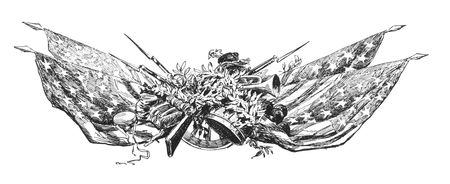
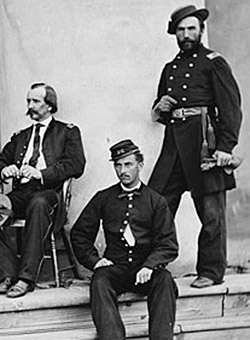
14 11 second list
~~~~~~~~~~~
LAYAWAYS ARE WELCOME:
Need to split your order into multiple payments? No problem! A simple 20% earnest money deposit will hold your item for you.
You can then pay it off in easy installments that fit your budget.
~~~~~~~~~~
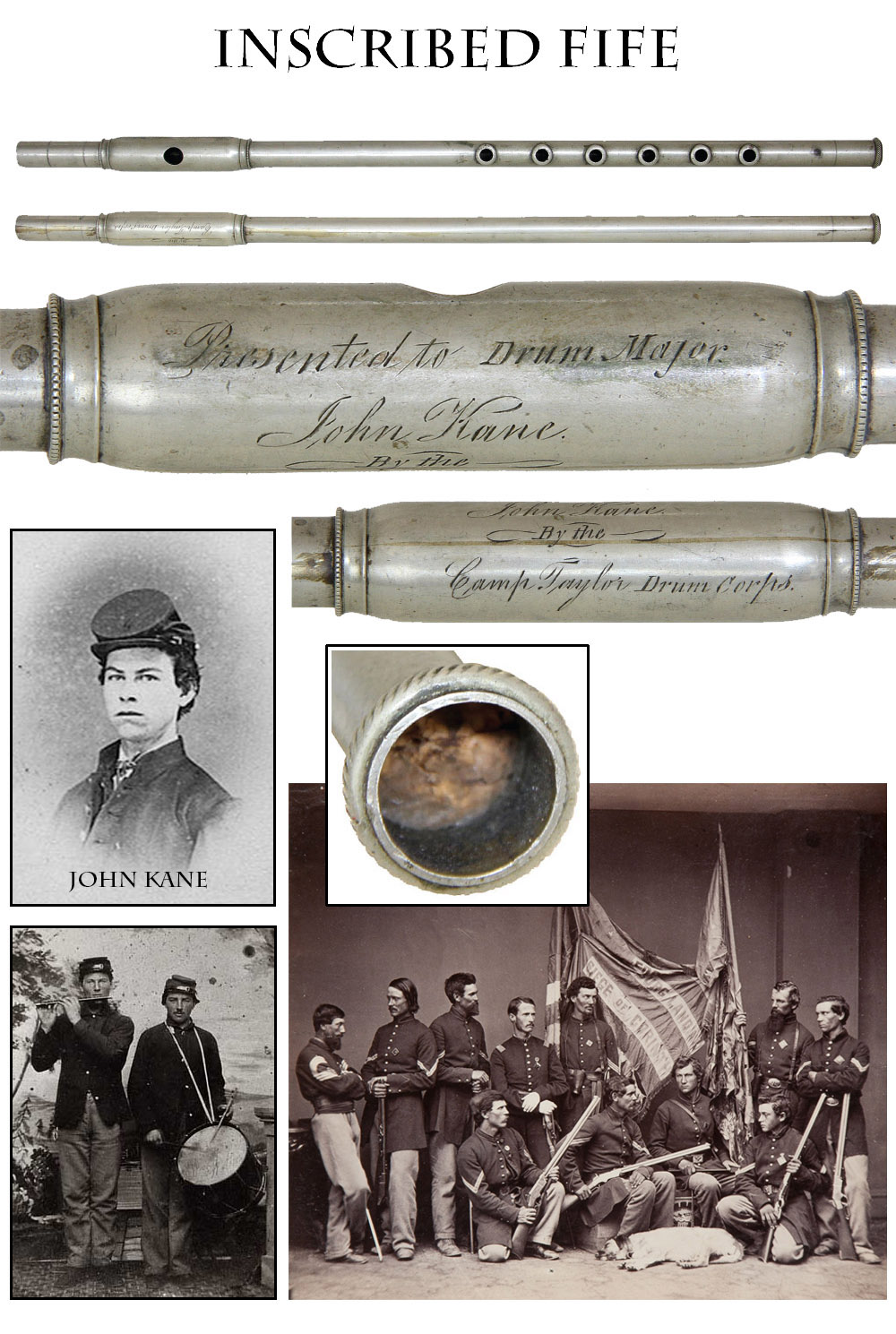
14-11-41 … 7th Illinois Inscribed Presentation German Silver Fife / The Henry Rifle Regiment !!!
… Civil War presentation German-Silver fife, identical to the Confederate-used example illustrated pages 226-227 of Arms and Equipment of the Confederacy. It bears a beautiful period inscription on the mouth piece section: Presented to Drum Major / John Kane/ By the/ Camp Taylor Drum Corps. John Kane did at least two turns of service in the 7th Illinois Infantry: the first immediately following Lincoln s call for troops, as a musician in Co. G during the regiment s three month service in 1861, serving from 4/25/61 to 7/25/61. His name is sometimes spelled Kain or Kaine, but records make clear it is the same fellow. “Kane” then enlisted again (Civil War data does not give this date of enlistment) in the same unit after it went into service as a three-year volunteer regiment, enlisting and transferring to the Noncommissioned Staff as the regiment s Principal Musician, in which capacity he served until muster out on 7/12/65. Another entry shows a John Kaine musician enlisting 2/09/1864. This is the same time the veterans in the regiment returned from furlough to the front. My guess is that Kane, Kain, Kaine likely served 1861 through 1864 and reenlisted as a veteran for 1864-65. Or it is possible he served during the initial days of the war in 1861, then served as a camp musician in ’63-’64, and then rejoined the regiment at the front in 1864. A check of the monthly returns in the National Archives is the only way to know for sure. I will leave that chore for you. We know for certain he was at the front during 1861, 1864, and 1865. Kane died in California in 1916.
With the abolition of regimental bands during the second year of the war, infantry company musicians were often grouped together as a regimental drum corps under a Principal Musician sometimes referred to as the drum major. My research shows that Camp Taylor, Illinois was located near the Springfield brick yard. Reports from the period make it clear the Camp Taylor was not much for comfort or ambiance, it was a poor location chosen for expedience, the setting made worse by its proximity to the brick yard. There were numerous other camps near the brick yard. Fortunately the regiment spent little time there but enough for the drum corps to give Kane this top quality fife. (We show a photo of Kane from Civil War data web site.) The 7th Illinois was a hard-fighting western unit, serving in the Army of the Tennessee and most well known for its possession of Henry rifles. During Kane s service they used them to great effect at Allatoona, losing some 35 men killed in action against much greater rebel forces. One of the great misconceptions among modern day arm chair warriors is that they believe carrying one of the repeating rifles would make them invincible. On the contrary, the regiments carrying Henry or Spencer repeaters were the unlucky souls who were thrown to the front to stop an onslaught. The result being that soldiers carrying fast shooters were MORE likely to be wounded or killed. During the war the 7th Illinois suffered 8 officers and 81 enlistedmen killed or mortally wounded. The photo of their color-guard showing their flags, Henry rifles, and 15th Corps badges is one of the most dynamic Civil War photos extant. An extremely rare find. I can recall owning only two of these inscribed instruments in the last forty odd years. Wonderful … zbc
… $2,850.00 SOLD
Click Here to E-mail Us!
Call us @ 419-842-1863

14-11-42 … War of 1812 Era American Eagle Pommel Sword:
This sword and the following belt were sold to me in October of 2014 by a customer who was acquainted with a descendant of Gen. George Pickett. The Picket descendant wished to raise some funds for an unexpected expense. There is absolutely no evidence that these items were owned by the famous Confederate, but they definitely descended through that family lineage. Pickett s father Robert was born in 1799 and would have been of appropriate age to carry such items but again I have no evidence of chain of ownership over the last two centuries and am simply conjecturing. Untouched attic condition US officer s eagle pommel saber showing some silver wash on the brass hilt indicating use by an infantry officer. Measures 37 inches overall length. White checkered bone grip with a floral band at top, one short narrow age crack at top inboard side. Dark, uncleaned eaglehead perched on top of the stirrup hilt with down-turned quillon and langets. Very handsome. There is a very thick ancient leather pad in place under the guard. It has been there since the swords period of use. Blade decorated with blue and gilt for about half its length with mixed floral and military motifs and very patriotic eagle with shield clutching a ribband with motto. Bluing is very visible, but shows some fading and rising brown spots underneath. Lower half of blade is silvery gray with darker areas toward the tip. With this is the sword s original leather scabbard. The mounts are long gone, but with some searching a suitable set might be turned up. (In fact I have a silver plated top mount that is a very close fit that I will sell for $75, though you might prefer waiting to find mount and drag that are matched.) In any event the leather sheath is the hard part to find. A good and early eagle-head with an interesting lineage …
… $650.00 SOLD
Click Here to E-mail Us!
Call us @ 419-842-1863
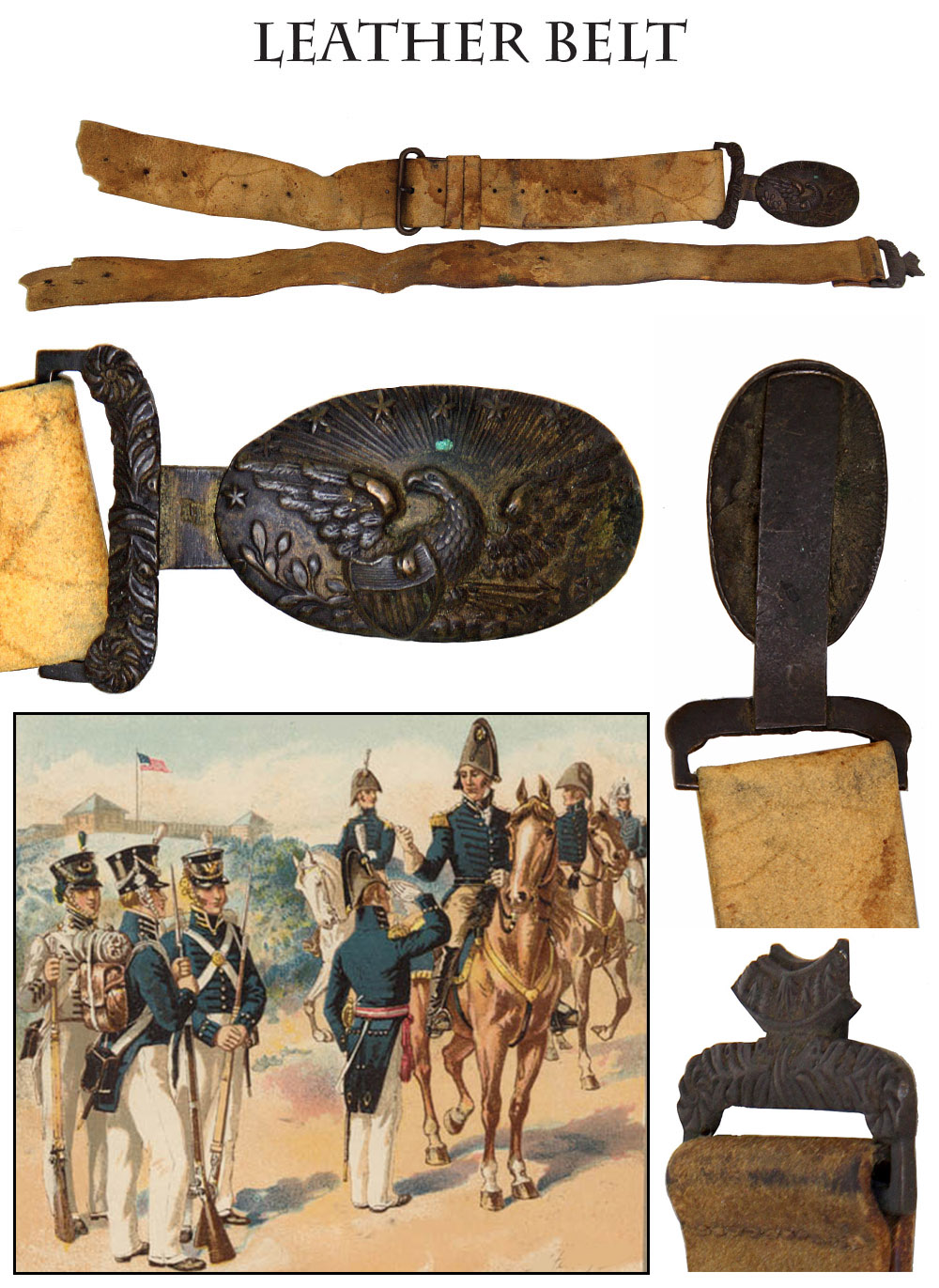
14-11-43 … Scarce Ca. 1820-1830 Officer s Oval Eagle Plate on Remains of its Sword Belt …
This belt and the above listed sword were sold to me in October of 2014 by a customer who was acquainted with a descendant of Gen. George Pickett. The Picket descendant wished to raise some funds for an unexpected expense. There is absolutely no evidence that these items were owned by the famous Confederate, but they definitely descended through that family lineage. Pickett s father Robert was born in 1799 and would have been of appropriate age to carry such items … but again I have no evidence of chain of ownership over the last two centuries. This buckle can be called truly rare. It is an elongated oval interlocking tongue and wreath belt plate showing a dynamic spread winged eagle with sunburst rays behind it, a U.S. shield in front, an olive branch of peace on one side and arrows of war on the other, surrounded by stars. This is a variation of the regulation infantry officer s belt plate adopted in 1819. See O Donnell and Campbell plate 126. In addition to army and militia use, they show an example used by a navy officer as well. The belt loop shows deeply cast and chased floral designs. The wreath portion has a matching belt loop, but the wreath itself is tragically broken off and missing. When I was first contacted I was sent some pictures by email. The pictures did not show the wreath so I assumed it was intact. When the package arrived I was completely deflated to see the damaged wreath. The belt is a thin white buff leather with two slides and an adjusting buckle. It too has a break and shows dirt and age staining. The patina of the plate is undisturbed and while it is too bad the wreath is damaged, the central portion of the plate with the key design elements is present and visually striking. It is one scarce plate. A very eye catching early relic
… $425.00 SOLD
Click Here to E-mail Us!
Call us @ 419-842-1863

14-11-44 … Socket Bayonet for the 1842 …
Nice Civil War production socket bayonet for the 1842 pattern smooth bore musket with its bottom stud. Nice even silver/gray with clear US stamp at the blade base and functioning locking ring. These bayonets with the rounded shoulders are the 1861 era examples as opposed to the squared shoulder bayonets which were made in the 1840s. The Civil War specimens with these rounded shoulders are FAR scarcer. A key piece of Civil War equipment with a lot of variation for the collector
… $250.00 SOLD
Click Here to E-mail Us!
Call us @ 419-842-1863
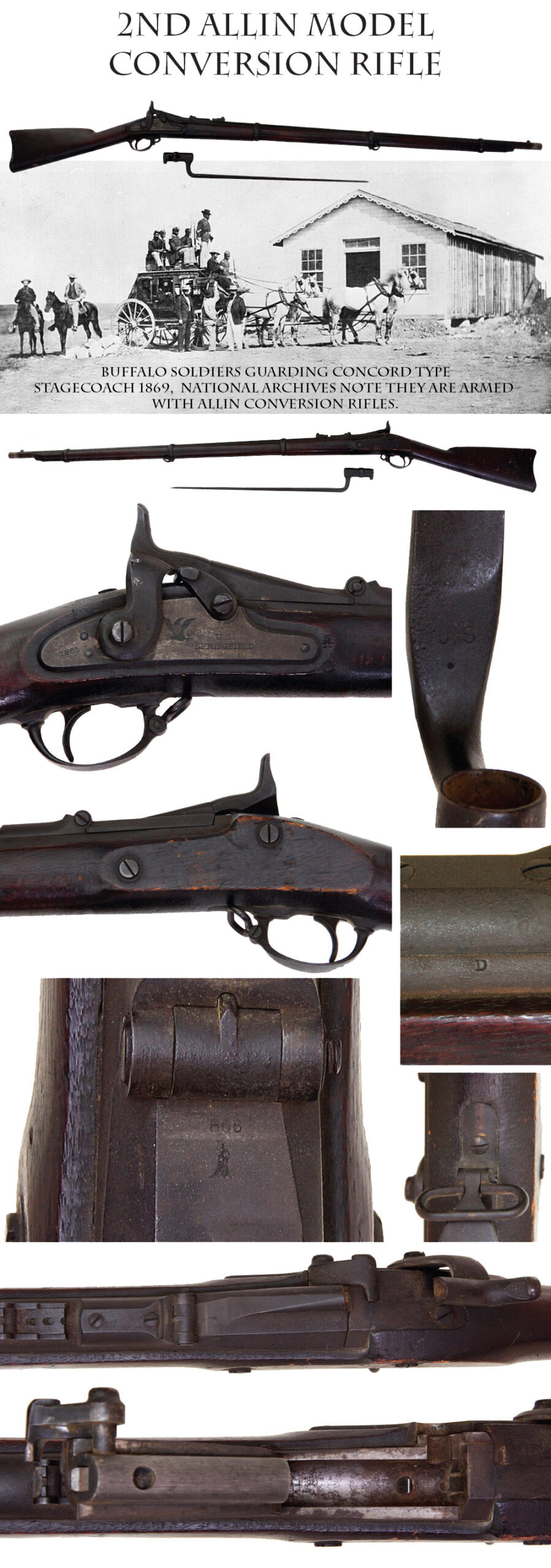
14-11-45 … Early Indian War Second Allin Conversion .50 Caliber Trapdoor …
This is the unsung gun that actually opened up the early west, before the days of Wild Bill and Buffalo Bill and the rest of the flamboyant cowboys. The Model 1866 breech loading Springfield rifle: the pattern issued to western troops and used at the Hayfield Fight and the Wagon Box Fight in 1867 to enable a small group of soldiers to hold off much larger Indian forces. This one is a crusty veteran right out of the attic, the way I like to find them: untouched but with sharp edges to the wood showing the gun was not abused, just put away and forgotten for more than a century. About 25,000 of these trapdoors were made in 1866 by modifying Model 1863 rifle muskets. The barrels are sleeved to .50 caliber and fitted with trapdoor breeches to enable them to be breech loaded with centerfire cartridges. Very sharp 1865 Springfield lock markings with the correct 1866 date over an eagle head on the trapdoor, just a tad light on the first digit of the date. Lock is a thin brown with gray showing underneath. Other metal is generally brown with surface crude, some minor raised scaling at the breech that could be cleaned. The wood has good edges, showing just some light handling abrasions. Mechanically good. Bore could use a cleaning as well. Breech still shows correct black finish from oil-quenched casehardening and lock plate shows lighter from water-quenching. Both would come up with careful cleaning: plate shows bright under gray and brown. Breech has some surface crud. Swivels and sights in place. Cleaning rod missing, but an easy replacement. The bore is VG to Fine with sharp rifling and some surface dirt. Original bayonet with the rifle, showing a clear US, and some pitting at base. A most affordable antique Springfield rifle
… $950.00 SOLD
Click Here to E-mail Us!
Call us @ 419-842-1863

14-11-46 … 1832 Dated Model 1816 Springfield Percussion Conversion …
Early form cone-in-barrel conversion to percussion of an 1832 dated 1816 Type III pattern musket made at Springfield. Sharp lock markings and very clear ink wood cartouches opposite the lock. Small sub-inspector marks and re-assembly codes from its arsenal conversion clearly legible. Some light pitting near the nipple from firing, otherwise smooth metal in age-muted national armory bright. All swivels, bands, springs in place as is the correct ramrod. Nice color to the wood with a good fit to the metal, just minor handling marks and one small crack between the upper lock screw and the breech of the barrel on the left side.
In the late 1840s the government surveyed and classified flintlock arms in its armories for suitability for conversion. The best and most recent were converted to percussion by removing the external lock parts, shaving off the brass pan flush with the plate, changing the hammer, sealing the touch hole and then cold forging and tapping the upper breech for a percussion nipple. The lack of the small brass semi-circular insert soldered into the remains of the brass flash pan may indicate this was one of the guns converted at the Nashville, Tenn., state armory in 1860. They purchased one of the Percussioning Machines at the Pittsburg Arsenal along with 3,000 hammers and nipples to convert their own muskets, many of which would have ended up in Confederate hands. In any case, the lack of the insert is one of the diagnostics in identifying their conversions, which otherwise are like the Federal arsenal conversions according to Moller. Some were rifled to try to bring them up the 1855 standards, but the pressure created by the minie cartridge was too great and thousands remained in arsenals in this configuration to be issued out to the volunteers in 1861 who thronged the state recruiting depots on both sides. Roughly 1,500 altered 1816s remained in the hands of just the New York troops in the field at the end of 1862. A nice looking musket that shows an important stage in US arms development and key weapon in the early years of the Civil War
… $1,150.00
Click Here to E-mail Us!
Call us @ 419-842-1863
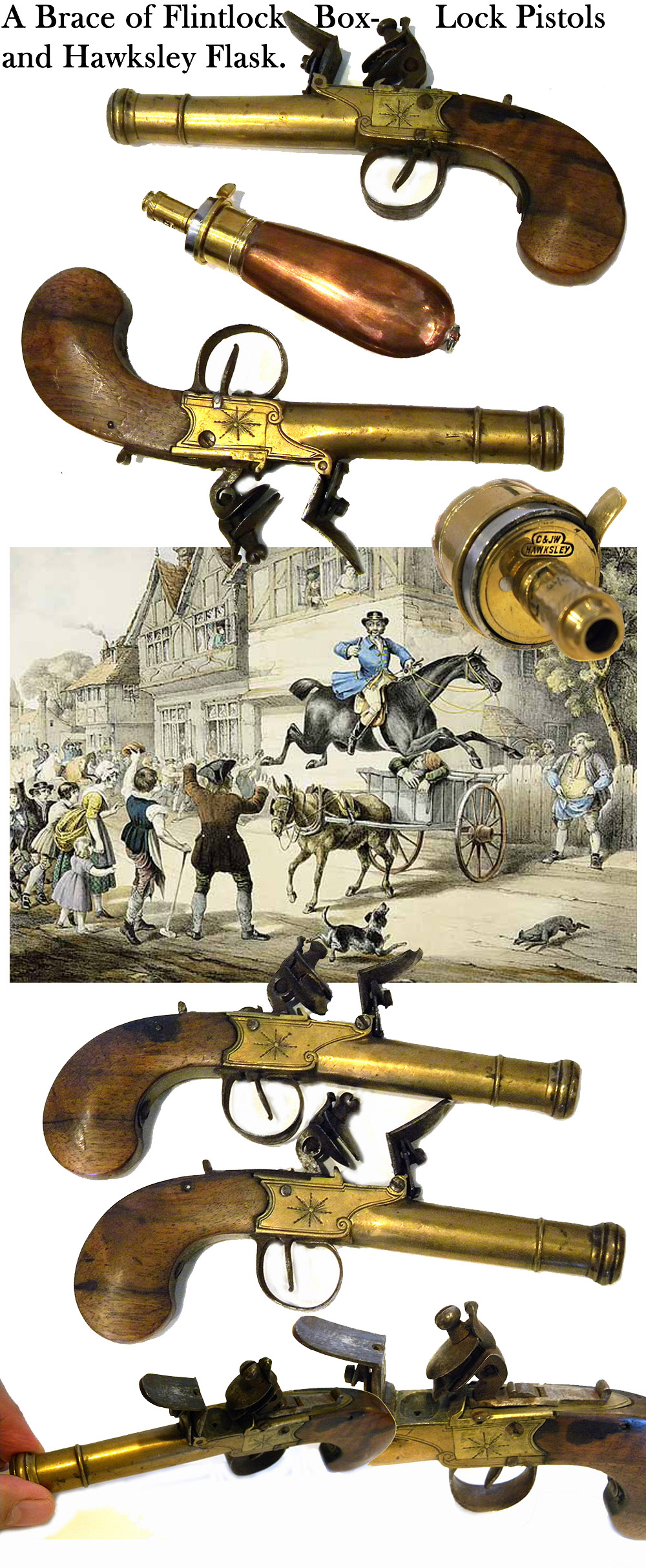
14-11-47 … Fine Matched Brace of English Box-Lock Pistols and a Nice Hawksley Flask: A true pair.
Roughly .50 caliber. 4 inch barrels, just under 8 inches overall length. Very attractive brass barrel flintlock pistols circa 1830, and exactly the thing a daring gambler would carry in his belt or pockets when out and about for a long evening. Both are NRA vg to fine condition. 100% original, 100% complete, and mechanically perfect. Also included is a very fine copper and brass powder flask, 4.5 inches long with a lanyard ring in the bottom. Top nicely marked C & JW Hawksley. This is in excellent condition and has been maintained in the bright exactly as we see in British Arms museums. A fine set of early arms at a most affordable price. The set
… $1,275.00 SOLD
Click Here to E-mail Us!
Call us @ 419-842-1863

14-11-48 … Excellent – Approaching – Mint Remington Zouave Rifle with Bayonet! …
One of the most handsome of all US martial longarms and a top drawer specimen. Extra fine condition. Retains about 100 percent barrel blue, and sight blue. Color casehardened lock with just a minor stain to right bottom of the U.S. Crisp lock markings: 1863 aft of the hammer with an eagle and Remington s Ilion N.Y. and U.S. forward. Sharp V/P/eagle barrel proof and crisp STEEL barrel marking on left flat with barrel inspector initials R.S.L. Beautiful oil-finished walnut stock with sharp edges and just very minor handling dings and some tiny chips at the base of the breehplug tang. Vivid ink inspector cartouches opposite the lock. Nice lively color to the brass trim: nosecap, bands, triggerguard, buttplate, patchbox, etc.- not age darkened and not polished up either, just mellow untouched. The patchbox even retains the extra nipple screwed into the wood in the bottom corner. Sights, bands, springs, swivels, etc., all in place. Great bore, mechanically excellent. I can t praise this gun highly enough. And, with it, I am including the correct brass-hilted saber bayonet. Matching patina to the brass, bright blade with just some scattered gray spots. Correct B.H. mark on the top grip below the muzzle ring. Functional spring-button lock. We all know these rifles as the Remington Zouave because they are such a pretty gun, and many collectors rank them up there with Mississippi Rifles. The technical terminology is Remington Model 1862 U.S. Contract Rifle. Remington got the contract for these rifles in 1861. It was replaced in 1862 and then extended to permit eventual delivery of 10,001 guns. Modeled on the 1841 Rifle, they are .58 caliber and incorporate aspects of the 1855 series of arms and even the style of band that shows up on the 1864 rifle muskets. This gun is a real showpiece. The only trouble is that you will have the itch to upgrade every other gun in the collection. Very fairly priced at
… $2,950.00 SOLD
Click Here to E-mail Us!
Call us @ 419-842-1863
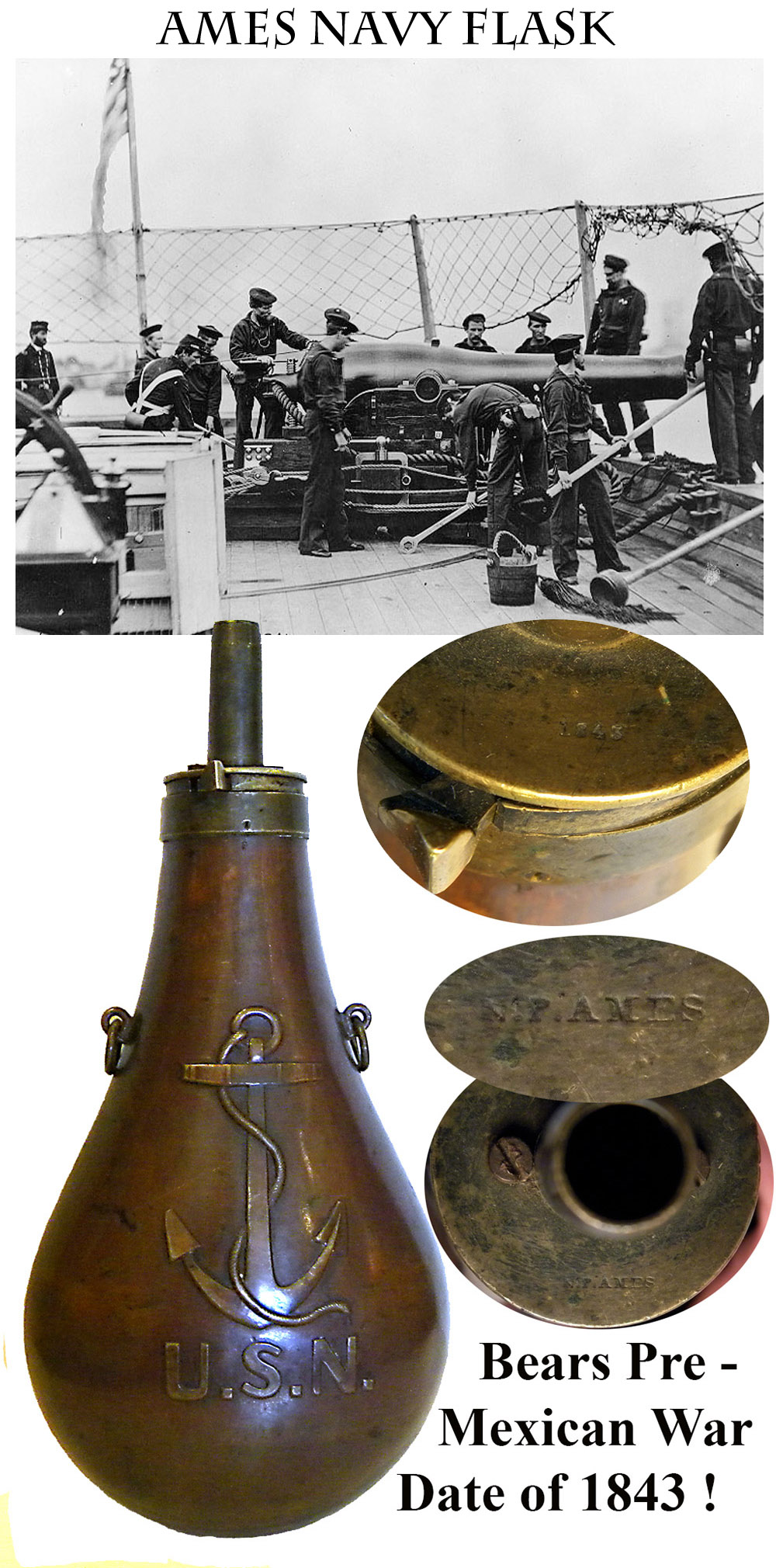
14-11-49 … Near Mint Condition – First year of Production – Ames 1843 Pattern U.S. Navy Powder Flask …
Nice pre-Mexican War date, 1843, which is also the first year of production. The U.S. Navy contracted with the Ames Company for 2,834 of these flasks in March of that year, the same time the company was supplying the Navy Boxlock Percussion Pistol and the 1841 Pattern Cutlass, and just after that, the Jenks Navy Rifle and Carbine. The guns are important and scarce; the flasks are even rarer, and this one is a beauty: even and deep untouched patina to the copper body and brass mounts, no dents, seam intact, carrying rings and brackets in place, crisp embossing and inspector marks. Correct non-adjustable spout and thumb release with concealed spring on the brass top with two screws. Clear N.P. Ames to one side of the spout with just a tiny bit of corrosion on the first letters, and on the other side the date 1843. Inspector initial P stamped on the neck below the brass collar. Nice large fouled anchor over U.S.N. embossed on the body. Carrying rings and brackets still in place. No dents. Seam intact. A wonderful condition, scarce early USN accoutrement necessary to go with that boxlock pistol or Jenks rifle. About perfect condition
… $1,175.00 SOLD
Click Here to E-mail Us!
Call us @ 419-842-1863
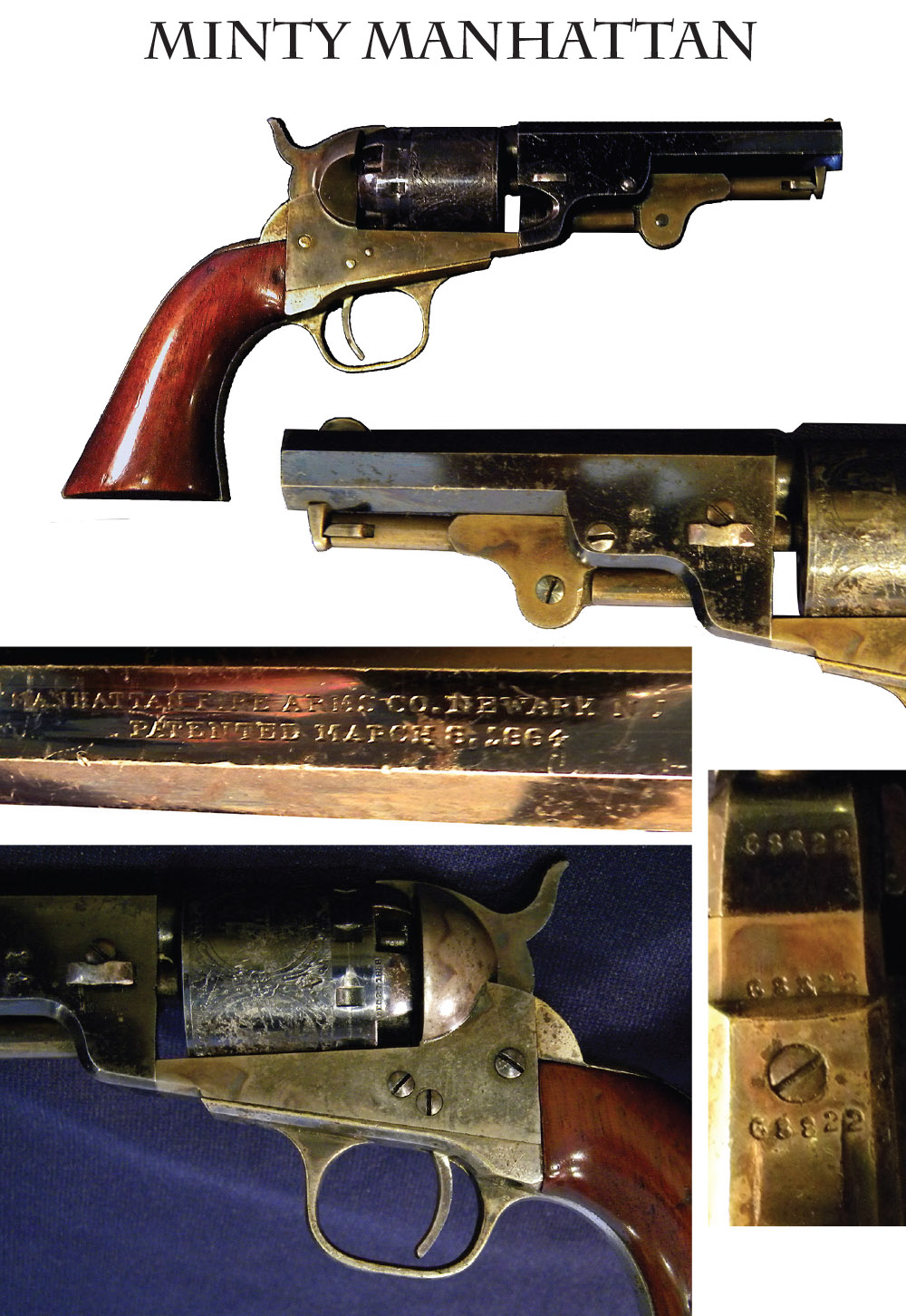
14-11-50 … Superb Near Mint Manhattan .36 Cal. Revolver With Beautiful Blue and Case Color …
Without question the best condition Manhattan navy revolver I have owned. Truly exceptional condition. I love these rivals to Col. Colt because they are largely the same gun but cost about one tenth the price in high finish. The Manhattan Firearms Company started in 1856 and prospered in the wake of the expiration of Colt s patents in 1857. Though never actually based in Manhattan, the marking implied they were there which certainly added a certain appeal. Their five-shot .36 Caliber revolvers were very similar to Colt s 51 Navy and 49 Pocket models. Here is a top drawer example of the Series IV Manhattan Navy with five inch barrel, a sharp two-line barrel address incorporating their March 8, 1864 patent information and enough original blue, case color and cylinder scene that you could add a zero to the price if it were Colt product. Beautiful unblemished grips and brass back strap showing traces of silver as does the triggerguard. 95% or better smoky case colors on the frame, hammer and shield, and 95% lustrous blue covering the cylinder which has deeply etched panels showing a sailing ship, charging soldier on horseback, etc. Barrel retains about 97% brilliant, reflective fire blue, with some light surface scratches visible. Nice case color on the loading assembly as well. The cylinder bears the 1859 patent date and also a crown/v and crown/p, as does the frame, indicating Manhattan sold this on the British market, where the Brits proofed the gun upon receipt. This in itself is an interesting and rare feature. This seems a very high end attempt to make inroads in the British market since Sam Colt had given up the attempt in 1857. Matching serial number 68,822 throughout, which places it toward the end of the production run, which reached just over 69,000.
This displays like a million bucks and is a great piece for a late Civil War or early west collection, or any collection of high finish early firearms. A true investment quality antique revolver
… $3,850.00
Click Here to E-mail Us!
Call us @ 419-842-1863
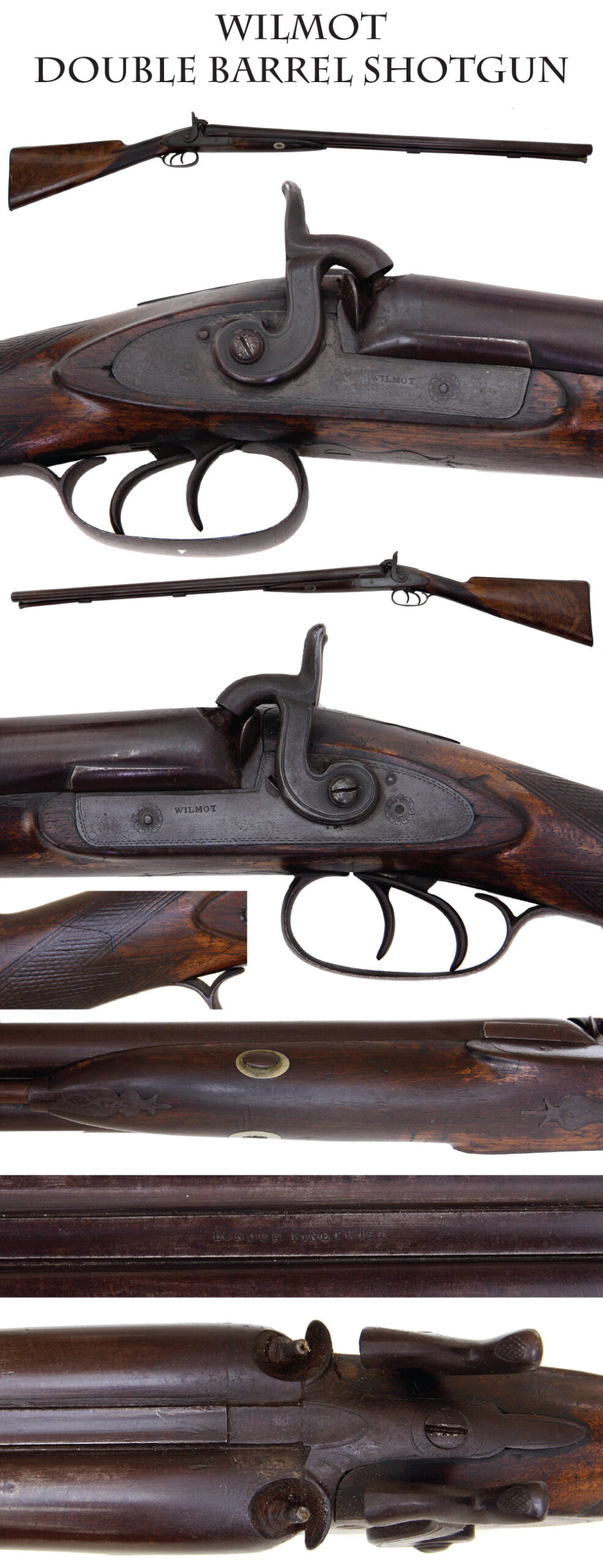
14-11-51 … Wilmot Double Barrel Percussion Shotgun …
Full-length double barrel shotgun marked Wilmot on either side of the lockplate and London Double Twist in the sight channel between the barrels. Original ramrod, typical short forestock with single wedge to reduce weight, nice checkering at wrist and a very attractive patterning of the wood on the buttstock flats. Smooth metal overall showing a rich plum brown patina resulting from oxidation of the blue finish. Lock has matching color, nicely done decorative edge border and floral motifs around the screw ends. Small crack right wrist, otherwise nice edges to the wood. Underside of forestock shows wear to the finish from handling. Whoever bought this had good taste, used it, but took care of it. Mechanically perfect. A nice sporting arm of the Civil War period, and more than a few were brought into service by southern gentry at the beginning of the war to bag a yankee. Most affordable
… $250.00 SOLD
Click Here to E-mail Us!
Call us @ 419-842-1863

14-11-52 … William Moore Breech Loading Double Barrel Shotgun …
A solid old late 1800s breech loading shotgun. Perfect for display with a Wild West Stagecoach theme. Note the ad shown with it. Clearly notes it was sold to the American market. William Moore & Co. English double barrel cartridge shotgun with great funky barrel release lever. 12 gauge, nice barrel markings: Laminated Steel Company markings on rear of back-action lockplate. 29 inch barrels. 45 inches overall. Checkered forestock shows an ancient surface crack running under the wedge. Nicely checkered wrist. Barrels a thin blue turning plum. Breech, receiver and lock more a silver/gray with dark gray and some brown, but a nice consistent look. Helper Tom had just put on his tweed jacket with elbow patches and deerstalker cap and was heading out the door with this when I grabbed it from him. Apparently he slipped into his Downton Abbey persona and thought he might go gunning for some birds. A really interesting Victorian levered breech mechanism … abe
… $265.00 SOLD
Click Here to E-mail Us!
Call us @ 419-842-1863
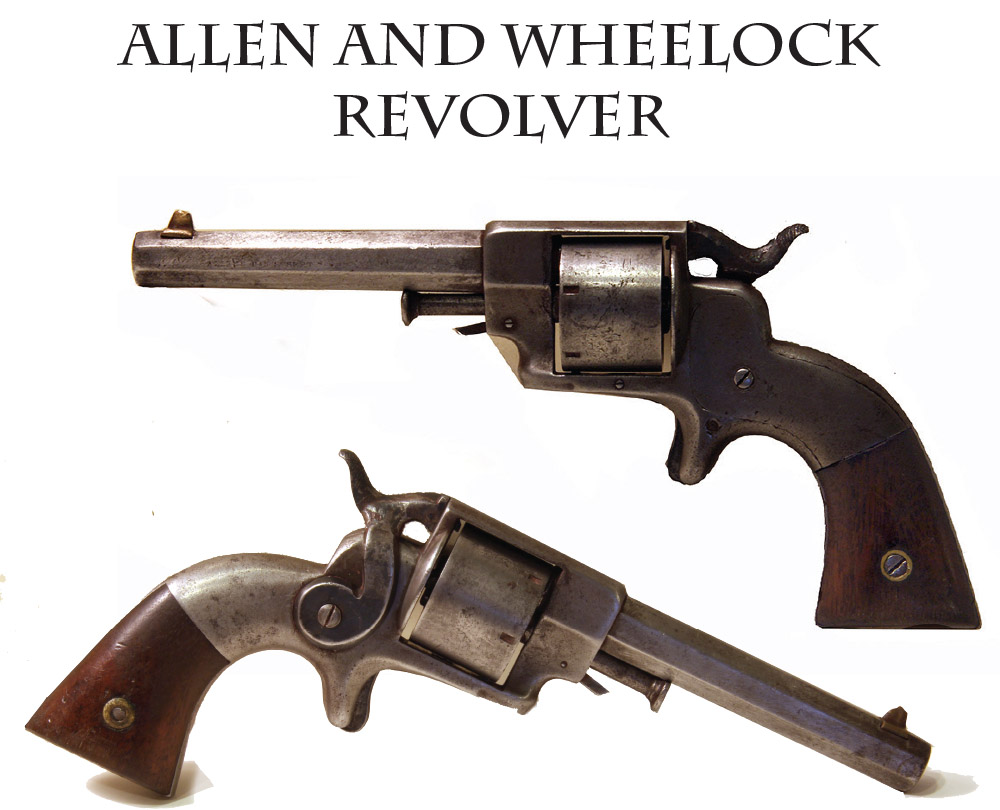
14-11-53 … Allen and Wheelock .32 Cal. Sidehammer Rimfire Revolver …
Nice even dull grey color on the metal with some darker color on the hammer. Ancient repair visible on the hammer spur. Very good wood grip with tight join to metal. Quick-drop form to the grip characteristic of the earliest models along with a mortised brass front sight. Not much of a bevel to the front of the frame at the barrel, but a rather square angle at the rear of the top strap, so we have a sort of transitional First/Second Model, but there were a lot of variations in this line of pistols though not many were made: Flayderman simply says over a thousand between 1859 and 1862. Side-hammer revolvers have a great 1850s look to them: a bit of the past in the side-hammer, a bit of the modern in the revolving cylinder. Barrel markings are nearly worn away otherwise fine. These are roughly the same size as a Colt Root revolve
… $350.00 SOLD
Click Here to E-mail Us!
Call us @ 419-842-1863
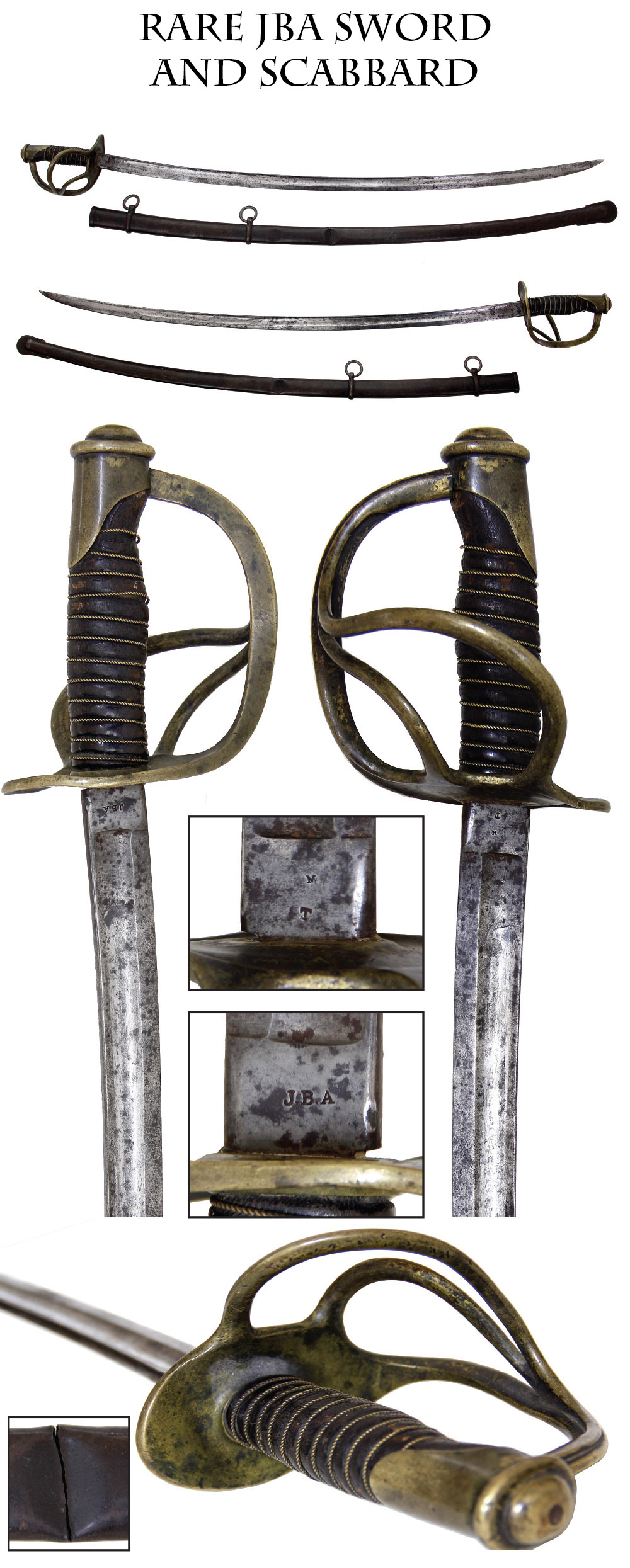
14-11-54 … Very Scarce JBA Marked US Cavalry Saber and Scabbard …
Sword historian John Thillmann devotes two pages to JBA marked 1860 pattern cavalry sabers in his book on the subject. He comes down on the side of those who think these were actually made by Ames or Emerson and Silver, though who JBA was is still unknown. At one time they were attributed to J.B. Allere of Chicago … but this theory has faded. Thillman says only two had been found in recent years, so they are scarce and ours may add a piece to the puzzle. I have personally owned three. Standard 1860 configuration: full original leather and wire on the grip. Blade shows bright in places, mixed with gray areas and dark spots. Good edge, no nicks. Blade washer is long gone and the upper part of the guard shows a wavy impact bend. Blade and grip are still solid, The scabbard must have taken a dive at the same time: there is a severe crease below the lower ring that has broken through completely on one side. A competent smith could sleeve this and reinforce it. Here s the cool part. Thillmann notes that the swords are unmarked with the exception of the J.B.A. and the presence of a W on the pommel of one example. Ours shows a W (or it could be an M ) on the ricasso opposite the J.B.A. stamp, along with a T, which is reminiscent of the T-stamp on the 1860s now attributed to Tomes of New York. Heritage Auction in Texas sold a nice one for $1,300.00 in 2008. They stated that less than 10 examples survive. I believe that low number is in error in a big way. I ve personally seen a dozen or more. I ll leave it to the scholars to battle it out on this one. This is a highly desirable saber, very scarce, and seems to add something new to the debate: gentlemen take up your positions … p-thi
… $675.00 SOLD
Click Here to E-mail Us!
Call us @ 419-842-1863

14-11-55 … Holy Grail Artifact / Incredibly Rare Ames Mfg. Co. 1860 Pattern Cavalry Officer’s Saber and the owners Spurs:
Cavalry officer’s sabers are rare in any form, but those made by Ames are extremely scarce. Overall fine to excellent condition retaining about 70% original factory luster on the blade. The firm name is marked in an arch on the ricasso. Classic Ames blade etching. The steel scabbard has a pleasant smoky grey patina. The brass guard and scabbard mounts exhibit an identical rich, undisturbed, and uniform century+ old age patina. Very handsome. Tied to this rare saber is an original pair of Civil War cavalry spurs. While we do not know who carried the saber and wore the spurs, I am keeping them together as they came together decades ago when purchased by an old friend of mine who sold me part of his collection earlier this fall. In November 2014 Bonham’s auction sold a near mint example for $11,115.00 including the premium. Ours is not mint, but it is fine, and ours was carried in the Civil War and priced a lot lower … ce
… $4,500.00
Click Here to E-mail Us!
Call us @ 419-842-1863
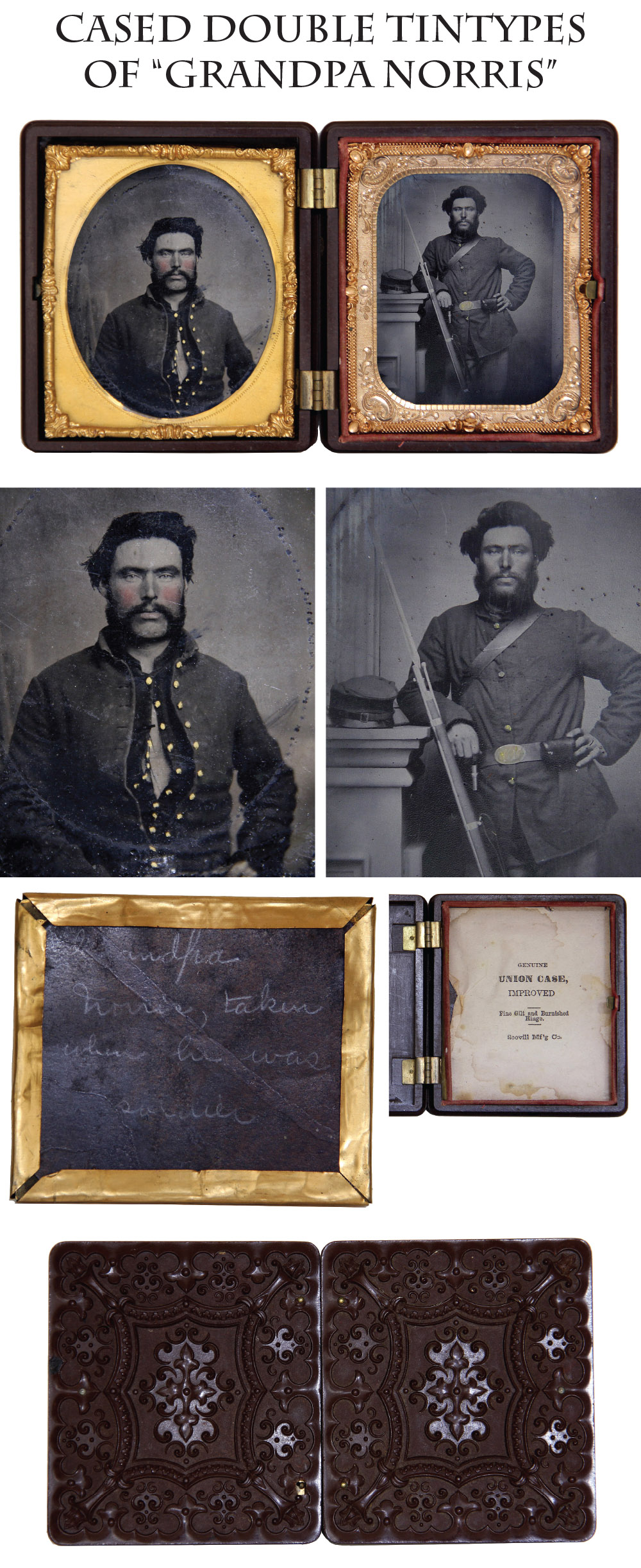
14-11-56 … Cased Pair of Sixth Plate Tintypes of Grandpa Norris, Taken When He Was A Soldier. …
Superb pair of tintypes in a fine thermoplastic double casing. The images were taken in two different sittings of what is obviously the same soldier with a family notation on the back of one. In one he appears seated waist-up in a shell-jacket that is open to expose a vest and watch chain. His buttons have been gilded and cheeks tinted, but there is good clarity and just minor mat marks on the plate. The companion view shows him looking a little shaggier, in a 4-button fatigue blouse, standing, hand on hip and leaning on a studio column, his forage cap next to, and an 1861 pattern rifle musket with its bayonet fixed leaning against the column as well. He wears a regulation infantry waist belt with oval US plate and a cap box. He has reversed his cartridge box sling, which hides the round eagle plate, but makes it appear to hang correctly on his right side to offset the reversal of the tintype process. Very good clarity and detail, wrinkles in his fatigue blouse and even what seems to be the socket of a bayonet on his belt as well, indicating he borrowed the rifle from another soldier in the studio or someone fixed another bayonet his rifle to save time. In this pose his cheeks have also been slightly tinted and a light gold wash applied to the belt plate that obscures but does not completely hide the U.S. The photos are housed in a nice thermoplastic double case with floral and geometric motifs. Frames, mats and glass in place. Scovill Union Case paper label intact in one side. There are an awful lot of Yankee infantrymen named Norris so researching that aspect would seem a needle in a haystack type of chore. But who knows. Super images in super case … g132
… $650.00
Click Here to E-mail Us!
Call us @ 419-842-1863

14-11-57 … Sheffield Dagger / Bowie Knife:
A classic Civil War fighting knife in overall VG condition. Made and signed by Sheffield’s most famous maker “G. Wolstenholm & Son Washington Works Sheffield.” Just under ten inches in overall length with blade just under six inches. (The knife in the hand of the clip-art rebel is larger.) Nicely aged bone grips. Marked “IXL” being a play on “I Excel”. Shows use and wear but no abuse. These Sheffield knives were carried by the thousands by Union and Confederate soldiers, as well as miners in the California gold fields. A very handsome antique weapon with wonderful patina
… $325.00 SOLD
Click Here to E-mail Us!
Call us @ 419-842-1863
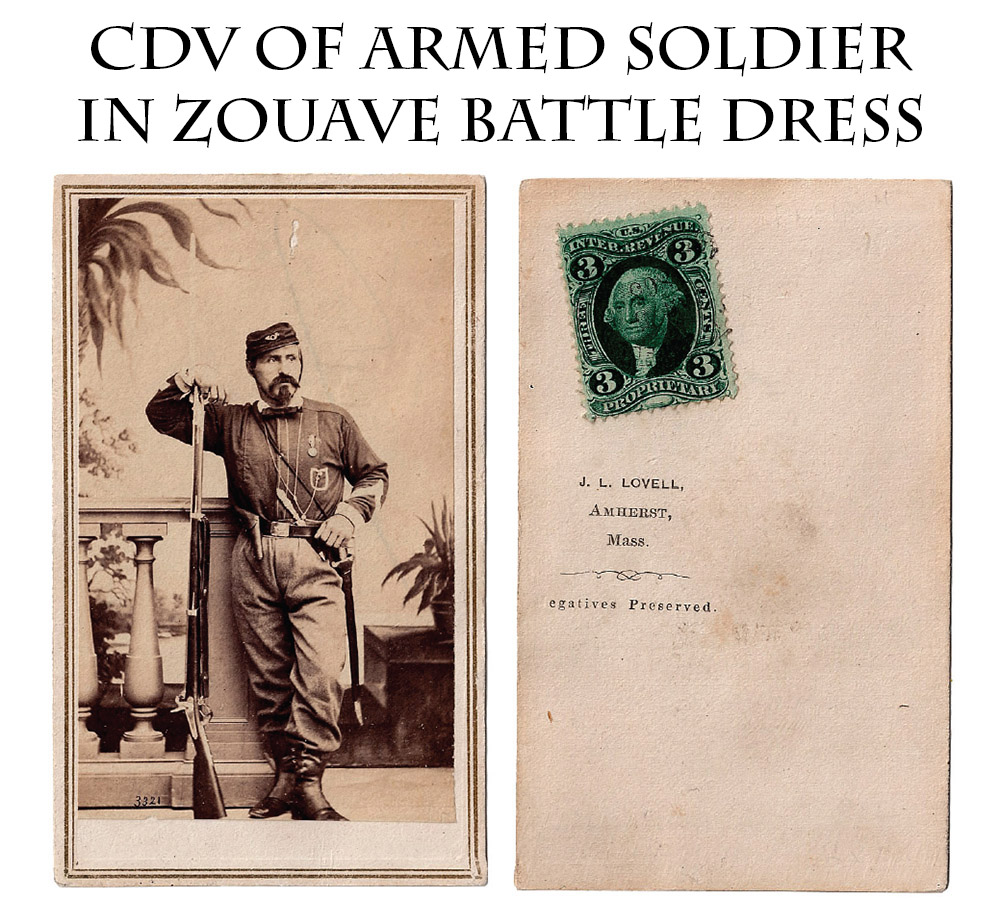
14-11-58 … Cutlery Handled Bowie Knife at the Ready …
Shades of Garibaldi! I don t know who this well-turned out fellow is, but he looks a lot like one of the many expatriates and veterans of the wars in Italy who made their way over here to fight for the Union. In any case, he is loaded for bear. He leans on a musket with fixed bayonet, pistol in a full-flap military style holster on his belt, a sheathed saber bayonet, and prominent cutlery handled bowie shoved in his belt for good measure! The CDV has an Amherst, Mass., backmark and a tax stamp dated Jan 1865 showing that our zouave was here for the war. The fellow is most likely part of a visiting military delegation. The numbers of foreigners from western Europe who came to fight and observe and serve are legion. He wears a low crown kepi with European hunting horn insignia and European style battle shirt with chevrons high up on the sleeve, somewhat baggy trousers and short gaiters. That dashing mustache and goatee is a real statement of style! His musket is distinctive but I cannot recall which pattern it is. His belt accoutrements tell the story. He has a revolver in a full flap holster and a cutlery handle Bowie Knife both of which give him just the right Civil War flavor. A magnificent piece of CW photography on all fronts and one that is worthy of research. The answer will be in the Amherst or Boston newspapers. A great CDV
… $450.00
Click Here to E-mail Us!
Call us @ 419-842-1863
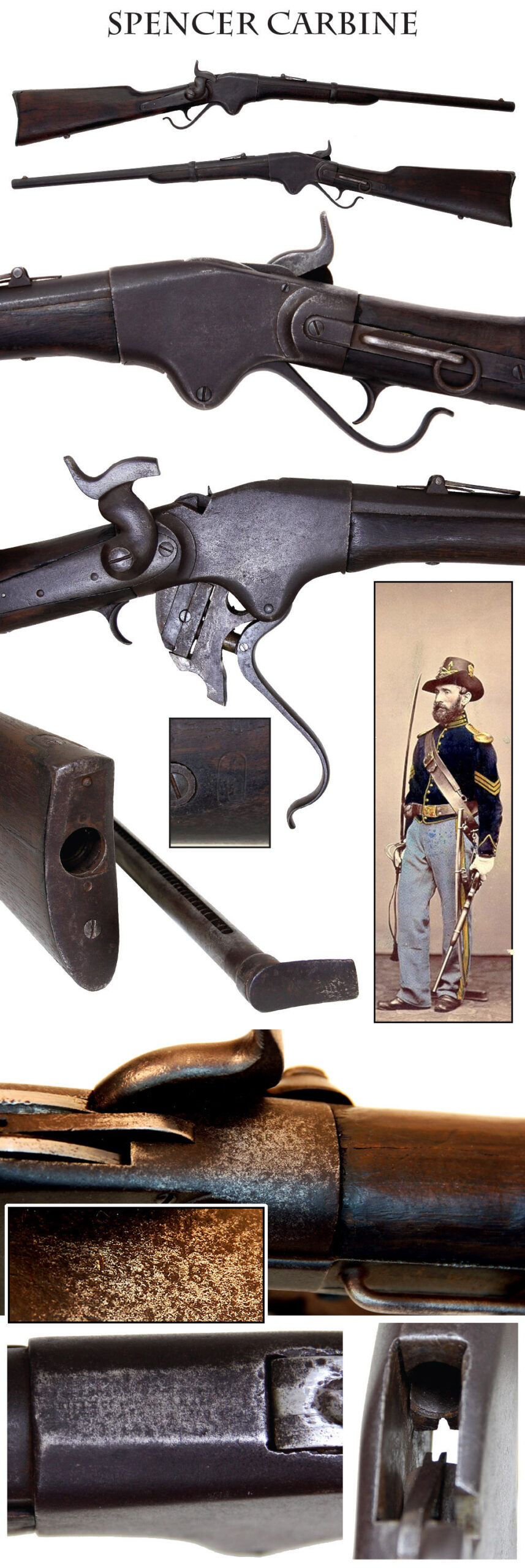
14-11-59 … Very Early Spencer Carbine …
Very early production Model 1860 Spencer carbine, serial #15,368. The first contract for Spencer carbines was given in June, 1863, and the first deliveries were made in the last week of September (officially listed as October 3.) Serial numbers for the carbines started at 11,000 and deliveries were made every two weeks in batches of a thousand. (The first 11,000 Spencers were 3- band rifles.) Ours falls, then, in November 1863, delivery. Records of this serial range show a lot of carbines in the hands of the 2nd Michigan Cavalry. I purchased this carbine in Saline, Michigan last month. No proof of issuance, but circumstantial for sure. This outfit saw a lot of action in the western theatre, suffering 47 officers and men killed in action and another 23 mortally wounded- a severe record for a cavalry unit. They recruited in Detroit and had as Colonels not only Gordon Granger, later a general, but Phil Sheridan himself. The carbine is in very good shape for such an early production gun with a lot of war service. The metal is a deep brown patina with hints of faded blue and some silver gray poking through. The wood shows some wear and shrinkage gaps at the metal joins. It has good color, is very solid with not a lot of handling dings, and even still has a visible inspector cartouche near the saddle ring bar. Shows a short crack running forward from the butt plate about two inches in line with the magazine tube, not unusual in a Spencer. The surface of the barrel is smooth, the metal showing a little roughness on the receiver, hammer, lock and butt plate, but nothing too bad and having matching color. Magazine tube is in place and draws fine, mechanically good, rear sight needs an elevation bar on the ladder and the front sight blade was refined during its period of use to give a sharper bead . The importance of the Spencer needs no repeating and it is one of the most recognizable Civil War guns. This one shows its Civil War use all over it … a classic war horse that unquestionably fought Johnny Reb. This is one of the lowest serial numbers I have owned on a Spencer. Most we find are in the 40,000 to 60,000 range. This one truly saw service in the great mounted campaigns of the war, and possibly in the saddle with a Michigander
… $1,950.00 SOLD
Click Here to E-mail Us!
Call us @ 419-842-1863
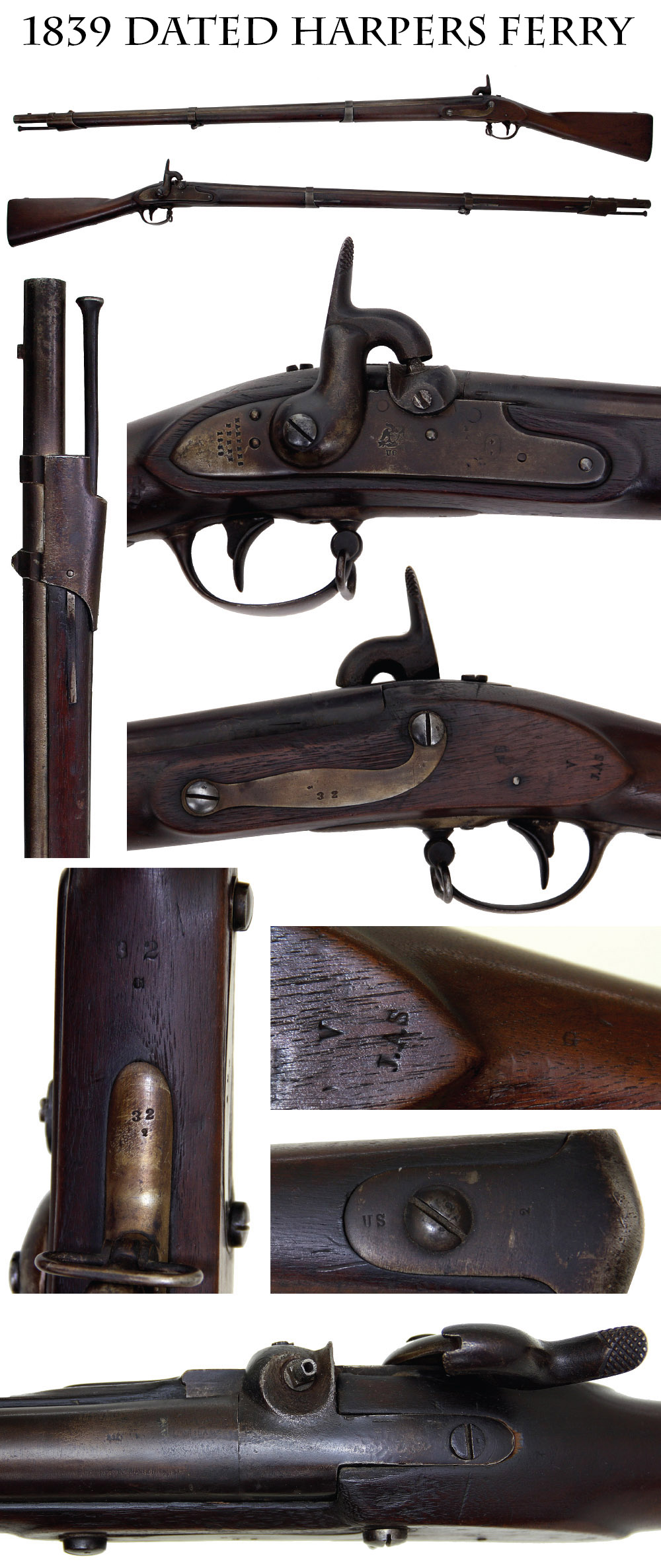
14-11-60 … Harpers Ferry Musket With Leman Chambered Breech Alteration …
As the country s southern arsenal, Harpers Ferry, Virginia guns made their way into hands of many troops heading off to war with Mexico and prewar southern militia units who later mobilized for the Civil War. Here is a nice 1839-dated Harpers Ferry 1816 musket that is not only pre-Mexican War but displays some interesting developments in arms technology. Metal is smooth overall with nice thin brown color to the barrel with some silver gray underneath darkening gradually to a deeper plum brown at the breech. Good edges to the wood, tight wood to metal fit. Smooth lock plate with silver/gray underneath a smoky purplish brown on the plate and hammer. Very clear Harpers Ferry 1839 marks at rear of plate and eagle over US forward of hammer. Good edges to the raised wood sections. Opposite the lock are inspection/view marks of V over J.A.S. which is probably John A. Scheffer (or Schaeffer.) Small assembly number on the sideplate and triggerguard. All swivels, bands, springs, swivels, ramrod in place. When the government surveyed its flintlock muskets for conversion to percussion anything dated 1831 or later was considered first class. The 1816 patterns, however, sometimes presented problems with the Federal cone-in-barrel method of conversion. The chambered-breech, however, was successful in the Maynard system and it was adapted for use on its own in converting flintlocks that had so far escaped conversion, but also in re-altering cone-in-barrel muskets. Ours would seem to fall into that latter category: the use of the chambered breech is clear and the use of a clean-out screw points to Henry Leman as the gunsmith. His firm altered (or re-altered) several thousand muskets both for Pennsylvania starting in 1861 and the U.S. government starting in early 1862. How a southern-made musket traveled from the arsenal of Harpers Ferry to end up in a Pennsylvania gunsmith shop opens up a lot of speculation. It is a very nice example of Harpers Ferry work and carries a lot of history with it … ijj
… $1,195.00 SOLD
Click Here to E-mail Us!
Call us @ 419-842-1863

14-11-61 … Civil War Officer’s Sash …
On our last email catalog we sold a freshly found Rio Grande Camp Knife. Well the same family sold me this sash just two weeks ago. I am certain it was worn by the same fellow who carried the knife. Unfortunately the descendants know nothing of the lineage. Regulation sash for all officers from Second Lieutenant to Colonel, and all services except Medical Staff. Woven silk with thick bullion turks-head knots and fringe. Originally crimson, the color has shifted on this to a maroon, as it has on just about every other one that survives. Several small holes in the body of the sash and one large tear about twelve inches up from one end. Some abrasion and loss of color to the upper ends of the tassels, fading to the turksheads. For all its age this displays very well and a few well-placed stitches would do wonders. Sashes were one method of designating an officer and they were part of his regulation uniform, tied and knotted beneath his sword belt. This would display well next to an 1850 foot officer s sword, but is regulation for cavalry and artillery as well
… $395.00 SOLD
Click Here to E-mail Us!
Call us @ 419-842-1863
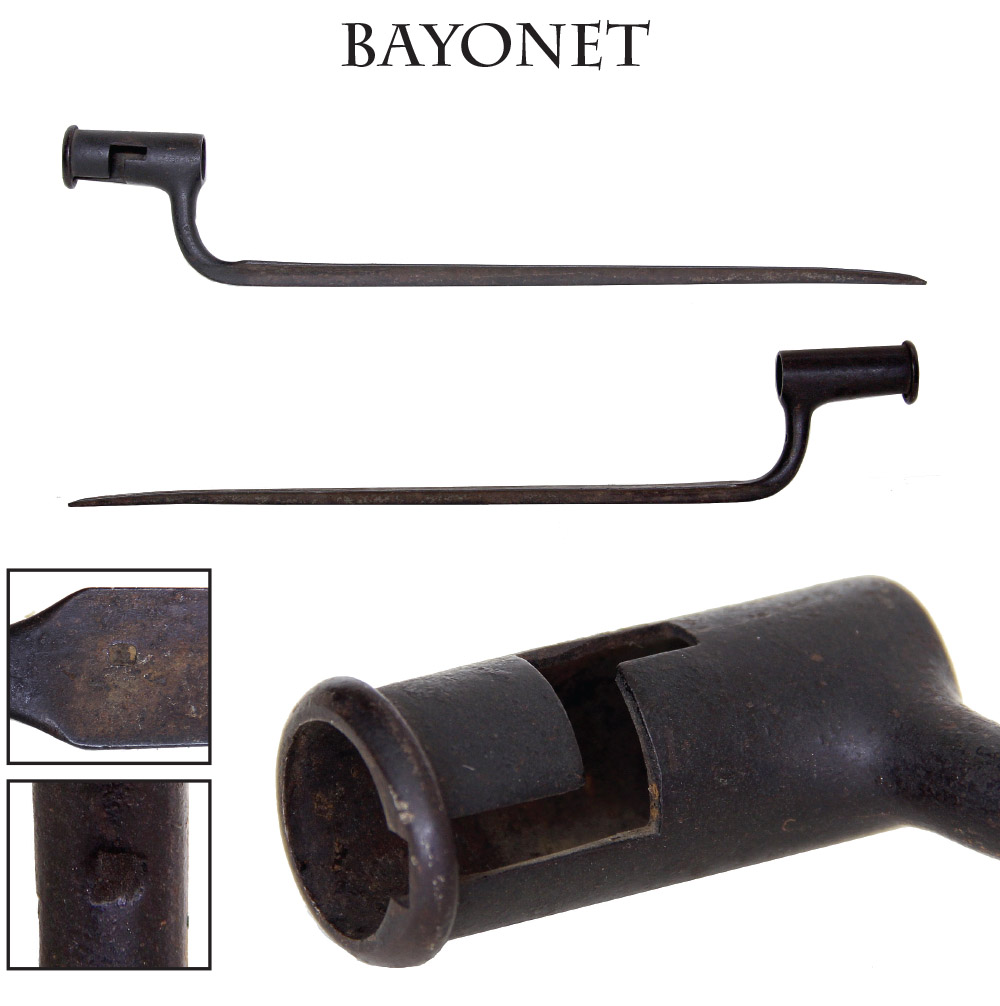
14-11-62 … Bayonet …
Socket bayonet with collar on the base. I haven t figured out which musket this fits yet – my gut instinct says it is for a British musket of the early 1800s. It may be a late Bess bayonet or militia piece. In any case it is a cool old bayonet and a good study piece to add to a collection. I’m too lazy to research it more… This price seems right for a two hundred year old weapon
… $150.00 SOLD
Click Here to E-mail Us!
Call us @ 419-842-1863

14-11-63 … Two-Band Enfield …
This is the pattern associated with Confederate sergeants. Great looking and very good condition Enfield short rifle (as distinct from the rifle musket), iron bands, brass nose cap, trigger guard and butt plate. Both sights in place, original ramrod, both swivels. Bayonet lug in place for saber bayonet. A very pretty gun. Crown at rear of lockplate, 1863 over Tower at front. Brass number 3 inset on the wrist indicating use by a militia group, numbering it for one of the men or for one of the sergeants, who often carried short rifles even where he men carried rifle muskets. Small metal scroll-design owner tag with stamped name Frank Dasso in between the lock screws opposite the lock- looks to me quite a bit later than the date of manufacture of the gun. Metal light silver gray with a dusting of brown surface rust that will come up like the lockplate with a careful cleaning. Some light pitting from firing at the breech. Barrel proofs a tad indistinct but there on the left breech. Sights, bands, rod, swivels in place. Mechanically good. Nice wood, great light brown tones, very few handling marks and with good edges. Bayonet stud in place at muzzle with mating number 5 for a saber bayonet. A very stylish rifle that was brought over in good numbers by both northern and southern agents, but seems mostly associated among collectors with southern imported arms … ajbe
… $1,495.00 SOLD
Click Here to E-mail Us!
Call us @ 419-842-1863

14-11-64 … Striking 1850 Foot Officer’s Sword …
The regulation sword for infantry lieutenants and captains. No scabbard and the wire on the grip is a bit loose, but look at that blade! I couldn t pass it up! Brass guard and sharkskin wrap are fine, the brass showing just some mixing of bright and age spots. Sports a stopped fuller, marked Iron Proof on the spine which translates as tempered steel. Extremely nice blade with vivid blade etching of floral, geometric and military motifs to beat the band: flags, shield, a prominent U.S. floral scrolls, etc. All set off in a muted background, not quite bright frosting, but setting it off dramatically. Some age spotting here and there, but pretty minor and the brightness of the lower un-etched portion of the blade shows the condition as well. You might find a scabbard for this, but why bother- you d only be taking it out all the time to show off the blade! They don t come along this pretty for this little money very often
… $495.00 SOLD
Click Here to E-mail Us!
Call us @ 419-842-1863

14-11-65 … 1864 Springfield …
The 1864 Springfield (aka M1863 Type-2) was the culmination of years of muzzle loading arms development in the U.S. and was the typical rifle musket in the hands of Union troops in the last year of the war. It is the last pattern muzzle loader made by Springfield. This one shows lots of real wartime use and an old cleaning, but is all there and still shows clear 1864/ Eagle/ U.S. /Springfield lock marks, eagle on the bolster, V/P/eagle barrel proofs, a trace of a barrel date and two ink inspector cartouches in the wood opposite the lock. Metal is a mottled brown and gray overall, and is missing the swivels, otherwise complete. Both sights, the barrel bands and band-springs, which are correct on the 1864, are in place, as is the rod and leaves on the rear sight. Crustiness and corrosion around the nipple. The lower rear screw behind the hammer needs to be repaired or replaced. For all that, a nice old soldier that would look good with a fixed bayonet standing in the corner or hanging over the mantle … g
… $975.00 SOLD
Click Here to E-mail Us!
Call us @ 419-842-1863
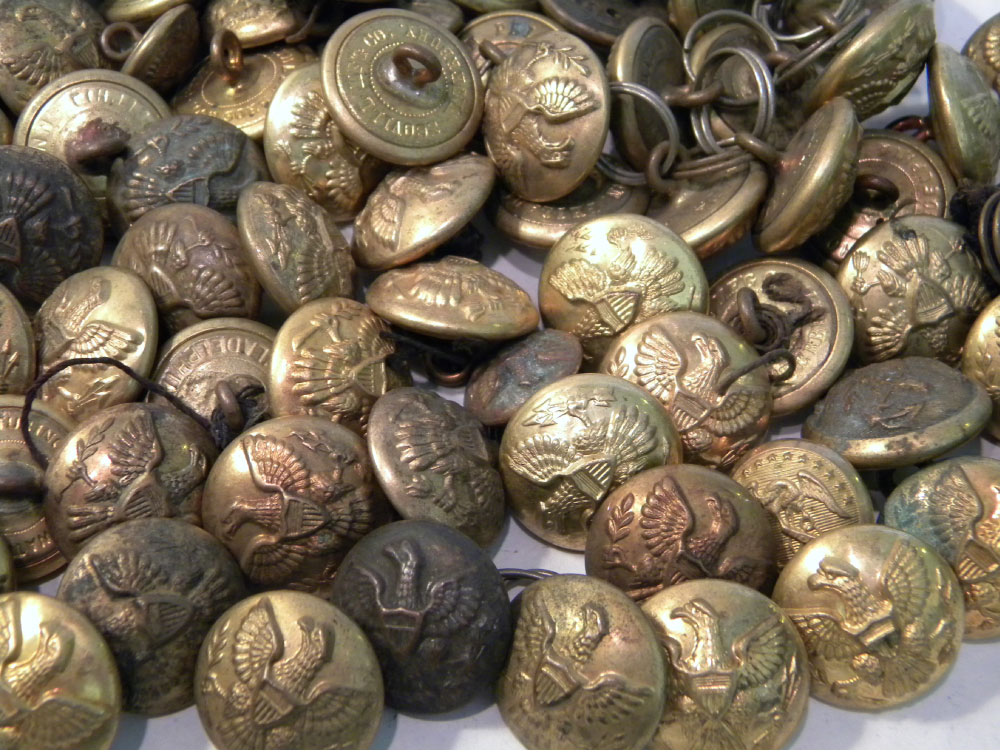
14-11-66 … A lot of TEN Original Indian War Large Size Eagle Coat Buttons.
A few years ago at an eastern Pennsylvania auction I bought a couple large bags full of these early Indian Fighters buttons and then I put them aside and forgot about them. I just stumbled across them again …. So here is a great opportunity…. ten original buttons for $25.00 These can be mailed inexpensively in a padded envelope.
… $25.00 for 10
Click Here to E-mail Us!
Call us @ 419-842-1863
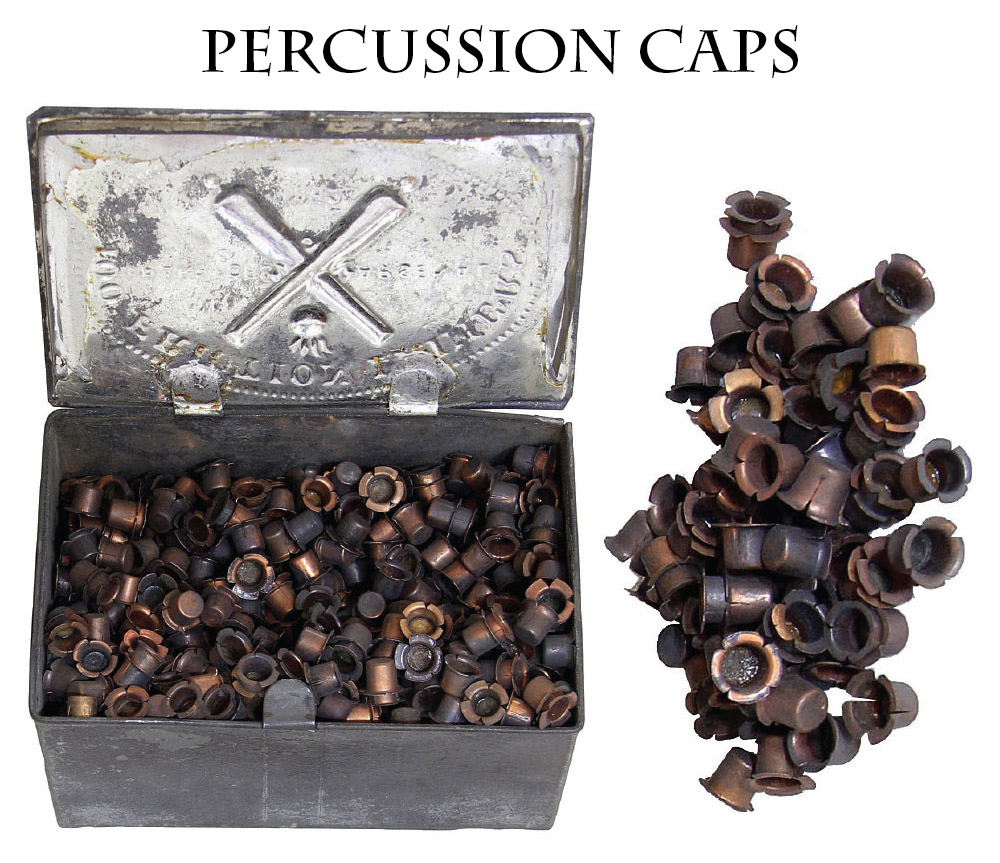
14-11-67 … Friction Primer Tin [ Tin not for sale] and Percussion Caps …
I just purchased this neat old relic and am offering the percussion caps inside the tin in this offering. This very scarce tin came just as you see it, filled with percussion caps for muskets. The tin itself is the arsenal tin used to hold artillery friction primers. These are darned hard to find! I can only think of one instance where I found one still in a primer pouch! The tin has a hinged cover with small latch and embossed top reading: 100 FRICTION PRIMERS in an arc over an ordnance insignia, and FRANKFORD ARSENAL on either side. I don t know who put the percussion caps in the tin, it was certainly a handy storage idea, but since they do not belong together, I am splitting up the lot.
In each package of ten cartridges the soldier got 12 caps. While the supply lasts I will sell the percussion caps …
One Dozen … … … $15
Two Dozen … … … $25
Five dozen … … … $50
Click Here to E-mail Us!
Call us @ 419-842-1863
Layaways are Welcome
Need to split your order into multiple payments? No problem! A simple 20% earnest money deposit will hold your item for you.-acf
You can then pay it off in easy installments that fit your budget.
Read Terms Here
Items to Sell? Contact Us
I am always interested in buying ANYTHING from the American Civil War… Guns, Swords, Civil War Muskets, Knives, Uniforms, Flags, Medals, Badges, Diaries, Letters, Autographs, Buttons, photographs, tintypes, daguerreotypes, Insignia, Camp Items, Battlefield Relics, canteens, Drums, Etc… Call 419-842-1863 and ask for Dave Taylor.

